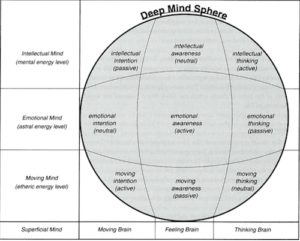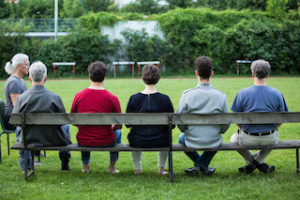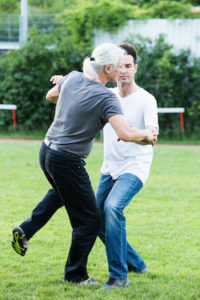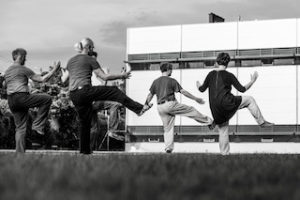On the Difficulty of Lasting Change in the Practice of Taiji
Abstract
Serious progress in the practice of taiji often requires far-reaching changes that can involve various levels of training. Christine Schneider investigates the question of why such changes are so hard to achieve and explains, on the basis of the teachings of Patrick Kelly, that a deeper level of consciousness is required for essential changes.
Considering how difficult it is to change old and deeply ingrained habits – and this applies equally to habitual movements and emotional patterns – it sometimes seems like a miracle that it is possible to change them at all. But exactly this is the task for those who set out upon the path to learning taiji: discarding old habits and adopting new ways, with the changes progressing as individually as people are unique.
It often seems that a teacherˈs words have very little visible impact. As instructors we are all familiar with the phenomenon that in spite of the most careful, repeated explanation and demonstration, students still do something else, sometimes even the opposite of what was asked of them!
Does this mean that, as an instructor, one has almost no ability to effect true and lasting changes to the movements of course participants? How then can it be that such importance is attached to the “lineage”, that is the chain of instructors through whom the teaching of taiji is transmitted?
Most practitioners know about the preeminent role of the teacher and his or her enormous influence upon their development. This influence can however be overestimated as well as underestimated. With all due respect for its role in teaching, one often overestimated channel of transmission is verbal explanation. Explanation is without doubt an improvement over the traditional Chinese system, in which little explanation is given and questions are not permitted. Explanations are also particularly useful in helping western practitioners access an art which is not part of their regional cultural heritage.
Complicated verbal explanations can, however, be taxing and lead to undesirable side effects which can remain hidden even to experienced instructors, insofar as they are not sensitized to certain signs.
The explanation for the fact that students ignore many of our instructions lies in the way that the human mind functions. In certain situations – for example information overload, contradictory sensory input (2), strong (and thus limiting) focus (3) and emotionally charged situations – our brain changes the way that it perceives reality in order to simplify, rationalize and cope with the situation.
The level at which the mind is operating also plays a role. With the term “Level of the Mind” I refer to Patrick Kellyˈs model, which frequently uses the term “superficial mind” for our everyday state of consciousness. This term is not meant pejoratively, and simply describes one end of a continuum, on the other end of which lie deeper – and not so easily accessible – layers of the mind (4).
Because it is easily accessible in our day-to-day experience, the waking, or normal state of consciousness is quite well known, as are the states of sleep, unconsciousness and coma. Exceptional situations such as high fever and other illnesses, sleep deprivation, unusually strong psychological stress or intoxication extend this spectrum. Not so widespread but well documented are experiences with trances induced through movements and/or rhythms, hypnosis and self hypnosis. With a model that recognizes only waking and sleeping states, one can only be awake or not.

Patrick Kellyˈs model of different layers of the mind that are closer to or more distant from our waking consciousness also allows for the possibility that the different layers operate simultaneously – something which requires lots of training and experience. An example would be the use of deeper (and therefore very effective) intentions with a full body awareness which is able to simultaneously perceive subtle pressure and temperature changes throughout the entire body even as the outer awareness (superficial mind) continues to operate. When pushing hands this awareness even perceives internal changes within oneˈs partner – a situation of extreme complexity!
The recommendation to calm the mind is commonplace in taiji. This is insufficient, however, and is just the very first step: allowing the superficial mind to become passive. We usually use the metaphor of “falling asleep” in training. Implicit in this instruction is that it applies to the most superficial layer of the mind, the layer which is able to fall asleep – so that deeper layers can “wake up”. Likewise, many schools recommend “rooting”, “sinking deeper” or “going deeper”, but understand the instruction only as applied to the body. Yet “sinking deeper” also applies to the deepening of the mind.

Only by training the mind in this sense, i.e. by exercising the deepening of the mind, modulating between different levels of consciousness and practicing the simultaneity of intention and awareness does the dilemma which arises from the limitations of everyday consciousness slowly become solvable. The superficial mind can only process a very limited amount of sensory information in such a way that the control of adaptive reactions takes place in a meaningful – that is, in the spirit of taiji principles – way.
This is why it is almost impossible for a beginner to change things which require subtle control. The superficial parts of the mind can only influence and manage a limited number of movements at once, and only in their rougher aspects. Fortunately there are so many gross adjustments that must be made in the beginning that they keep the superficial mind busy while students slowly learn to reach and use the deeper levels of the mind that are needed for more subtle changes.
Right or Wrong? Usually Neither One Nor the Other!
Sometimes students repeat a movement just once after I correct them and then ask: “Is this right now?” I can almost never answer such a question with “yes”, but neither could I answer with “no”. Why not? It should be reasonably easy to distinguish wrong from right.
The corresponding movement is not right in the first attempt after a correction – indeed, it cannot be right – because my intervention was very likely directed not at a small outer detail of the body posture or figure (which is simply a matter of knowing and remembering and can easily be changed), but rather at a second level of accuracy which is far more difficult to achieve and far more difficult to change.
- This kind of accuracy has to do with a dynamics of a figure, not the accuracy of a posture. My correction may have been related to:
- the way in which we move from one point in space to another,
- the way the different parts of the body synchronize in order to move in a wave,
- how the internal state of a muscle changes independently of the outer movement (a simple release may not be so simple if it has to happen at a certain time in a certain part of the body in a smooth and controlled manner while another part of the body does something else),
- how to explore and use the full range of joint movement,
- how the lower and upper body lift and sink with different timings to produce vertical compression,
- how and when exactly the arms connect, disconnect or reconnect to the torso in order to transmit the power from the center into the hands,
- how and when to move the mind inside or outside of the body,
- how to coordinate all of this with the internal changes and outer movements of a partner in the pushing hands,
- and innumerable further subtle details!

These corrections imply changes which are not so easy to implement and which require a lot of effort on the part of the student. There is an implicit prerequisite that the student sees what s/he is doing and understands what needs to be done. Only then is there a chance to change a habitual movement. As long as there is a gap between what the student believes s/he is doing and the actual body movement, there is not (yet) a chance to perform the correct movement. The main problem here is that the awareness, or listening, is not deep enough. In its everyday state a mind which is merely quiet and watchful will not pick up the feedback of those internal sensors which require a much deeper state of the mind to be heard.
Refining coordination of internal changes is much more difficult than refining the accuracy of the first level (the external movement) and takes many years. The accumulation of improvements to this precise coordination results ultimately in the suppleness which characterizes taiji at the highest levels. If the body is not integrated in this way then the effect of mind intention remains limited and below its potential – because de facto many uncoordinated (and partially unconscious) intentions are active.
Once the student perceives what is really happening, s/he can change it. Then it is only a matter of time and intense effort until habitual movements change. Little effort brings slow or no change. With a large commitment change will take place faster. If the concentration comes from a deeper level of the mind, the change can happen relatively fast. A strong concentration from a superficial level will also produce change, but will not reach and include the more subtle aspects of the movement.
Hence, although the categories of “right” and “wrong” certainly exist and are meaningful with respect to outer movement (facing left or right, stepping forward or backward, for example), the outer movement itself is not really important. To move correctly on this first level of accuracy is not so difficult (5) and does not require any internal change. Once one looks at the second level of accuracy, however, it becomes impossible for a beginner to move “correctly”. This does not mean that all of beginners’ movements are “wrong” – it is simply more appropriate to describe them as “more or less refined”.

All schools strive for refinement, but not all strive for the same kind of refinement. The difference is not difficult for a well-trained eye to see. With regard to change perhaps the most important factor is the intention to change. Often people say that they want to change, but as soon as they confront the reality of taking the first steps, they back off. The change suddenly threatens something they do not want to let go, or becomes too difficult. A mere superficial wish cannot overcome a deep-seated resistance, and therefore no change will take place.
At the same time, energetically and physically stored emotional experiences also play a large role. Our past contains good reasons for why we have become who we are, and for why we move and physically organize ourselves as we do. Not infrequently these internal resistances are the reason that beginners give up after the first few classes. Usually these psychological dynamics and the way they are triggered by certain physical practices remain subconscious, and reasons to quit training are found externally.
Ultimately the reason why someone wants to change, i.e. the motive, has a major influence on the prospects for success for the intended change. We are usually right where we need to be to get to where we want to go, so we should start by fully accepting our state of taiji development at this given point in time rather than trying to escape a state which we regret, reject or which we believe to be beneath our “true” ability.
In this context Patrick Kelly writes about the dichotomy of “acceptance” and “struggle” and about the importance of finding a balance between these two poles (6). Acceptance and struggle should operate simultaneously, not as antagonists – then they will contribute towards the rapid progression of an intended change in a person.
Despite all of the difficulties we experience the miracle of change in taiji time and time again. Our own efforts are indispensable, but luckily there is support: the examples set by experienced teachers and advanced students and the energy of a concentrated, practicing group are supportive without doubt.
Understanding the reasons why change is generally difficult should lead to an understanding attitude and clemency toward oneself – without thereby giving up the desire for more change.
Free Download of this article as PDF.

Author: Christine Schneider
encountered Patrick Kelly in the beginning of the 1990ˈs, which had a decisive influence on her further practice of taiji. As part of his network of senior instructors, she now holds international workshops in several European countries. Her interest in the complex relationships between mind, emotion, soul and body led to training in shiatsu and Hakomi therapy. She has led the taiji-schule in Vienna since 2011.
taiji-schule.at
Taiji in the tradition of Zheng Manqing, Huang Xingxian and Patrick Kelly
International workshops and seminars for advanced practitioners and instructors
Translation: Brett Carnito
Images: Sabine Pata
Sources:
(1) The German original of this article was published in “Taiji & Qigong Journal”, No. 4/2016
(2) For this there are a fascinating experiments: they demonstrate convincingly how the brain resolves conflicts when the sensory input, for example, from the eyes and ears and sense of touch are incongruent. Worth reading is for example Vilayanur S. Ramachandran/Sandra Blakeslee, Phantoms in the Brain: Probing the Mysteries of the Human Mind, William Morrow, 1998
(3) One of the most well-known examples is Christopher Chabrisˈ and Daniel Simonsˈ 1999 “Invisible Gorilla” experiment, http://theinvisiblegorilla.com/
(4) For more on this topic, see e.g. Patrick Kelly, Spiritual Reality: Deep Mind and Beyond, pba, 2005
(5) A highly debatable statement. Many taiji practitioners who struggle with the precision of their movements would argue against such a claim and even consider it provocative. My point is that outer accuracy is relatively simple compared to the subtleties and the required depth of an advanced training on the internal level, involving a range of timings of mind-body coordination and learning to synchronize different parts of the body in a wave-like motion.
(6) Patrick Kelly, Spiritual Reality: Deep Mind and Beyond, pba 2005, pp 62f

